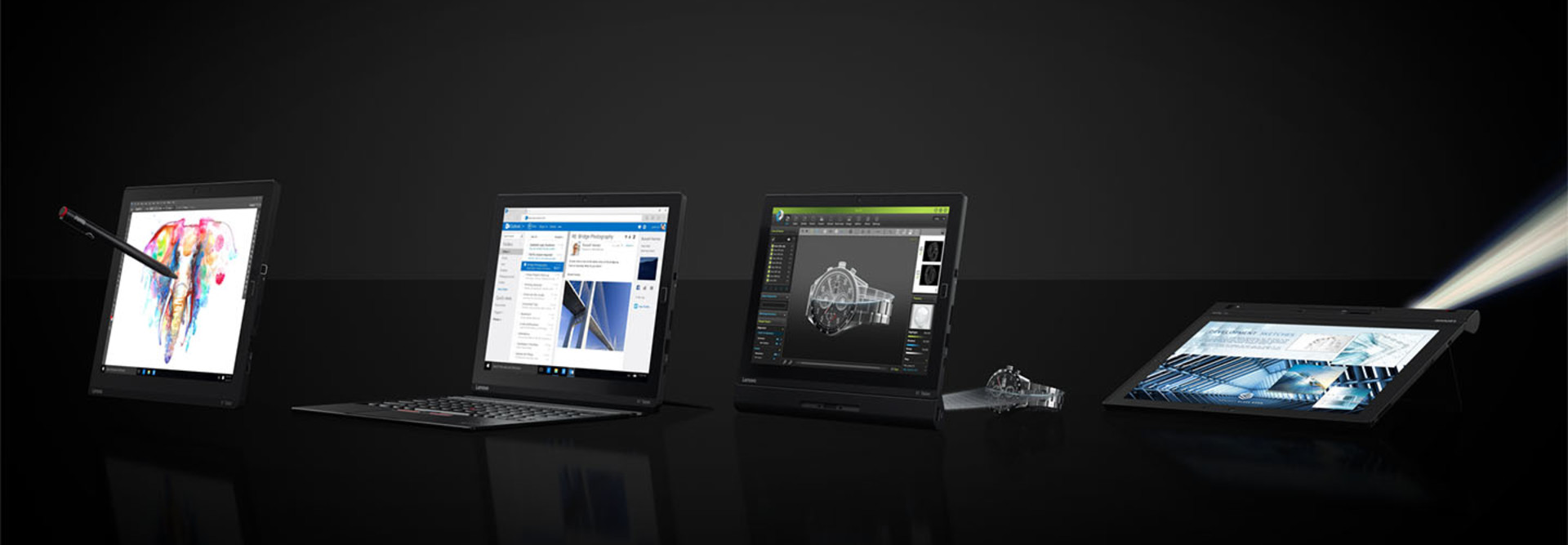CES 2016: HP, Lenovo and Toshiba Unveil New 2-in-1 Devices with a Fresh Look
The two-in-one device category is not new, but some of the biggest names in the PC market and consumer electronics are breathing new life into the product set at the Consumer Electronics Show in Las Vegas this week. Vendors such as HP, Lenovo and Toshiba are using the annual trade show to unveil new takes on the category, with flashier specifications and new designs and features.
The new gadgets are not specifically designed for the enterprise market but clearly have the potential to be included in enterprise settings. The vendors’ focus on the versatility and ease-of-use of the new two-in-ones is an indication that they are aiming at customers who care about productivity and flexibility.
New Wave of Products Coming
Lenovo was first out of the gate with its announcement on Jan. 3 of a new Thinkpad X1 family of products. The Thinkpad X1 tablet runs Windows 10 and can be attached to a magnetic full-size ThinkPad keyboard. According to Lenovo, together the tablet and keyboard weigh only 2.4 pounds. The keyboard has three adjustable typing angles and “recreates the classic ThinkPad keystroke feel,” Lenovo stated.
Further, the X1 tablet is the first Windows tablet to support LTE Advanced connectivity, according to Lenovo, enabling ultrafast mobile connectivity. The gadget sports a Qualcomm Snapdragon X7 LTE modem with LTE Advanced carrier aggregation support for up to 300 megabit-per-second download speeds.
Lenovo also announced the X1 Yoga convertible, which measures just 0.66 inch and weighs in at 2.8 pounds. The device has a patented “Lift and Lock” keyboard that retracts the gadgets keys when it’s being used in tablet mode, with the screen folded over. Additionally, the X1 Yoga also sports a pen that can be used to highlight or write notes on web pages when using the Microsoft Edge browser. The pen is also housed and charged inside the system, Lenovo noted.
HP got in on the game with a new version of its Spectre x360 convertible notebook that includes a 15.6-inch model with an optional 4K touch-screen display. According to HP, the screen will allow users to edit and consume 4K content in its native resolution, making it ideal for anyone working with HD video. HP has included optional Intel Iris graphics and up to 16GB of memory to boost performance. The gadget’s machined aluminum chassis houses a 64.5 watt-hour battery, the largest battery HP has included in any of its convertible PCs. The device has 9.5 hours of battery life when using a 4K display, according to the manufacturer, and 13.5 hours when using a 1080p HD screen.
And finally, Toshiba announced the 12-inch dynaPad tablet, which support an optional ultrathin, full-size keyboard. The keyboard is attached via magnets, which makes quick work of turning the tablet into a clamshell notebook for productivity applications.
The dynaPad also includes updated versions of Toshiba’s suite of business applications that let users collect, organize and share notes, images and files, and integrate them with Microsoft Office. The suite includes TruNote, a handwriting app that lets users take lecture or meeting notes, create detailed hand drawings, search handwritten messages, manage multiple notebooks and more. Another app is TruCapture, which allows users to capture images and text from whiteboards, textbooks, newspapers and other objects at any angle, so they can be imported into presentations and shared.
2-in-1s Could Appeal to Millennials in Enterprise
With these latest devices, vendors are aiming at both the consumer and enterprise markets, says Eric Smith, Strategy Analytics’ senior analyst for tablets and touch screens, adding that consumers who buy two-in-ones sometimes bring them into the workplace in bring-your-own-device scenarios.
All of the new two-in-ones announced at CES run on Windows 10, which now has an installed base of 200 million, and is a “credible operating system” that CIOs are familiar and comfortable with in terms of security features, says Smith. Enterprises could bring more of these two-in-ones into their offices and put them in workers’ hands as a way to make their device portfolios more secure, he says.
Smith points out that millennial workers expect to have mobile access wherever they are. That can certainly be achieved through the LTE connectivity of a product like the Lenovo X1 tablet.
“I think that, over time, there’s going to be some real benefits to the mobile desktop experience” that can be achieved through two-in-one devices, he adds.
“Mobility is one of the key drivers,” Smith says. “You’re going to have mission-critical employees who need access to the server or access to the cloud.”
IDC analyst Jean Philippe Bouchard says that pure tablets — those that are not two-in-ones — have not been adopted much in enterprise settings outside of limited niches like retail and healthcare. However, he says “the addition of a keyboard, serious processing power and larger screen will help fuel that growth.”
In terms of the new wave of two-in-ones, Bouchard says he is “not convinced” that IT executives and managers within enterprises “are looking at bells and whistles right now.”
“They are mostly considering price, portfolio roadmap [and] assurance that the lifetime of accessories will be respected,” he says. “And finally they are looking at sustainability of legacy applications already in use by their respective users.”









